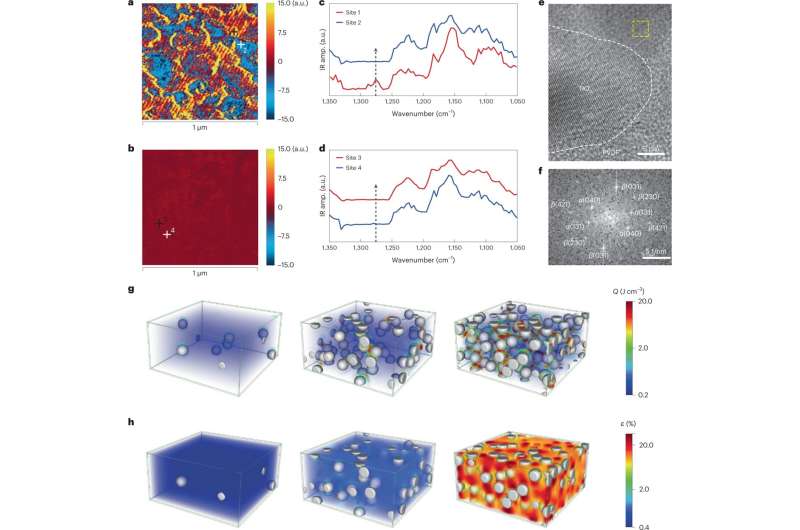This article has been reviewed according to Science X's editorial process and policies. Editors have highlighted the following attributes while ensuring the content's credibility:
fact-checked
peer-reviewed publication
trusted source
proofread
New ferroelectric material could give robots muscles

A new type of ferroelectric polymer that is exceptionally good at converting electrical energy into mechanical strain holds promise as a high-performance motion controller or "actuator" with great potential for applications in medical devices, advanced robotics, and precision positioning systems, according to a team of international researchers led by Penn State.
Mechanical strain, how a material changes shape when force is applied, is an important property for an actuator, which is any material that will change or deform when an external force such as electrical energy is applied. Traditionally, these actuator materials were rigid, but soft actuators such as ferrroelectric polymers display higher flexibility and environmental adaptability.
The research demonstrated the potential of ferroelectric polymer nanocomposites to overcome the limitations of traditional piezoelectric polymer composites, offering a promising avenue for the development of soft actuators with enhanced strain performance and mechanical energy density. Soft actuators are especially of interest to robotics researchers due to its strength, power and flexibility.
"Potentially we can now have a type of soft robotics that we refer to as artificial muscle," said Qing Wang, Penn State professor of materials science and engineering and co-corresponding author of the study recently published in Nature Materials. "This would enable us to have soft matter that can carry a high load in addition to a large strain. So that material would then be more of a mimic of human muscle, one that is close to human muscle."
However, there are a few obstacles to overcome before these materials can meet their promise, and potential solutions to these obstacles were proposed in the study. Ferroelectrics are a class of materials that demonstrate a spontaneous electric polarization when an external electric charge is applied and positive and negative charges in the materials head to different poles. Strain in these materials during the phase transition, in this case conversion of electrical energy to mechanical energy, can completely change properties such as its shape, making them useful as actuators.
A common application of a ferroelectric actuator is an inkjet printer, where electrical charge changes the shape of the actuator to precisely control the tiny nozzles that deposit ink on the paper to form text and images.
While many ferroelectric materials are ceramics, they also can be polymers, a class of natural and synthetic materials made of many similar units bonded together. For example, DNA is a polymer, as is nylon. An advantage of ferroelectric polymers is they exhibit a tremendous amount of the electric-field-induced strain needed for actuation. This strain is much higher than what is generated by other ferroelectric materials used for actuators, such as ceramics.
This property of ferroelectric materials, along with a high level of flexibility, reduced cost compared to other ferroelectric materials, and low weight, holds great interest for researchers in the growing field of soft robotics, the design of robots with flexible parts and electronics.
"In this study we proposed solutions to two major challenges in the soft material actuation field," said Wang. "One is how to improve the force of soft materials. We know soft actuation materials that are polymers have the largest strain, but they generate much less force compared to piezoelectric ceramics."
The second challenge is that a ferroelectric polymer actuator typically needs a very high driving field, which is a force that imposes a change in the system, such as the shape change in an actuator. In this case the high driving field is necessary to generate the shape change in the polymer required for the ferroelectric reaction needed to become an actuator.
The solution proposed to improve the performance of ferroelectric polymers was developing a percolative ferroelectric polymer nanocomposite—a kind of microscopic sticker attached to the polymer. By incorporating nanoparticles into a type of polymer, polyvinylidene fluoride, the researchers created an interconnected network of poles within the polymer.
This network enabled a ferroelectric phase transition to be induced at much lower electric fields than would normally be required. This was achieved via an electro-thermal method using Joule heating, which occurs when electric current passing through a conductor produces heat. Using the Joule heating to induce the phase transition in the nanocomposite polymer resulted in only requiring less than 10% of the strength of an electric field typically needed for ferroelectric phase change.
"Typically, this strain and force in ferroelectric materials are correlated with each other, in an inverse relationship," Wang said. "Now we can integrate them together into one material, and we developed a new approach to drive it using the Joule heating. Since the driving field is going to be much lower, less than 10%, this is why this new material can be used for many applications that require a low driving field to be effective, such as medical devices, optical devices and soft robotics."
More information: Yang Liu et al, Electro-thermal actuation in percolative ferroelectric polymer nanocomposites, Nature Materials (2023). DOI: 10.1038/s41563-023-01564-7
Polymer actuation using a Joule-heating-induced ferroelectric phase transition, Nature Materials (2023). DOI: 10.1038/s41563-023-01566-5
Journal information: Nature Materials
Provided by Pennsylvania State University





















